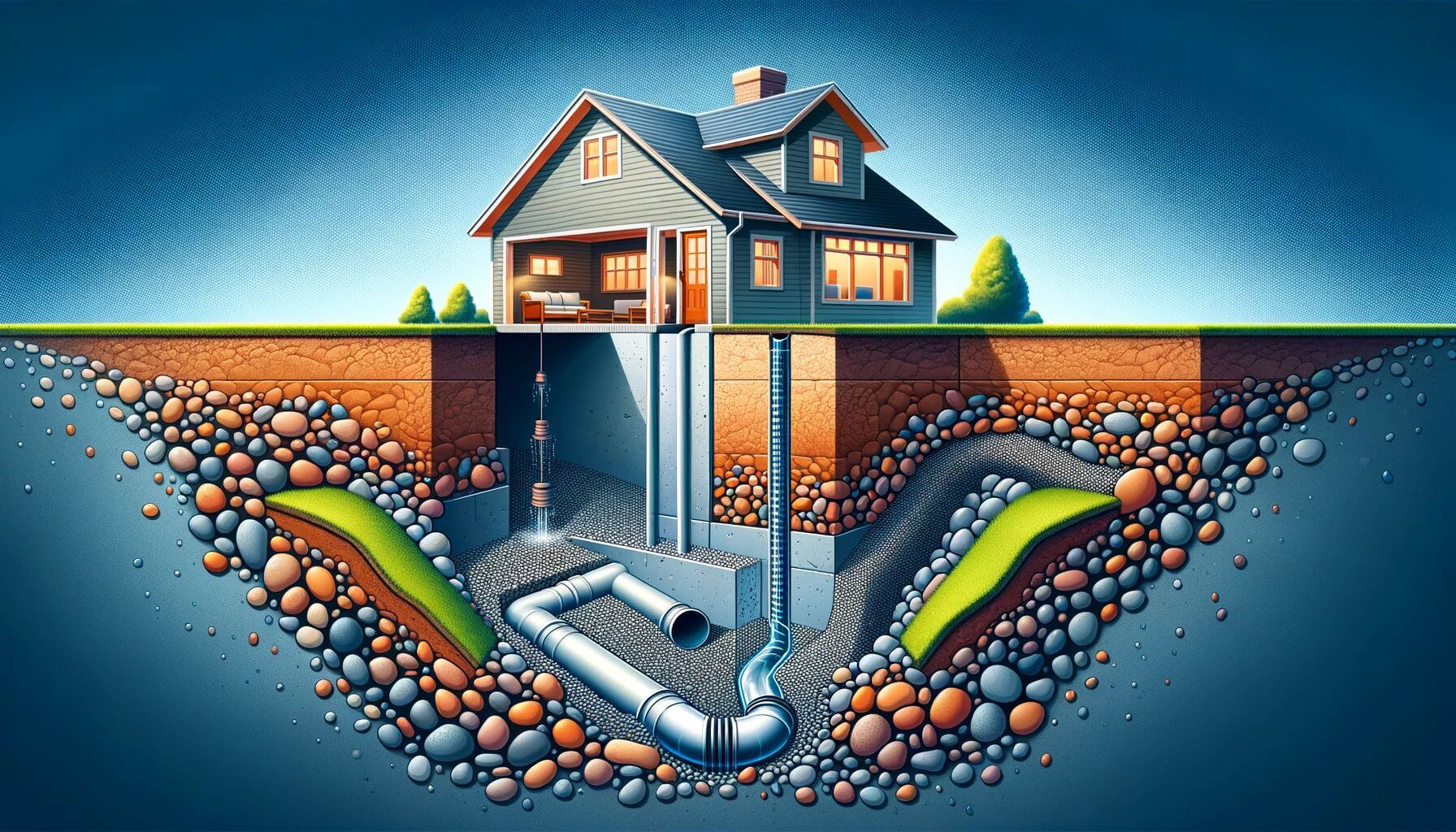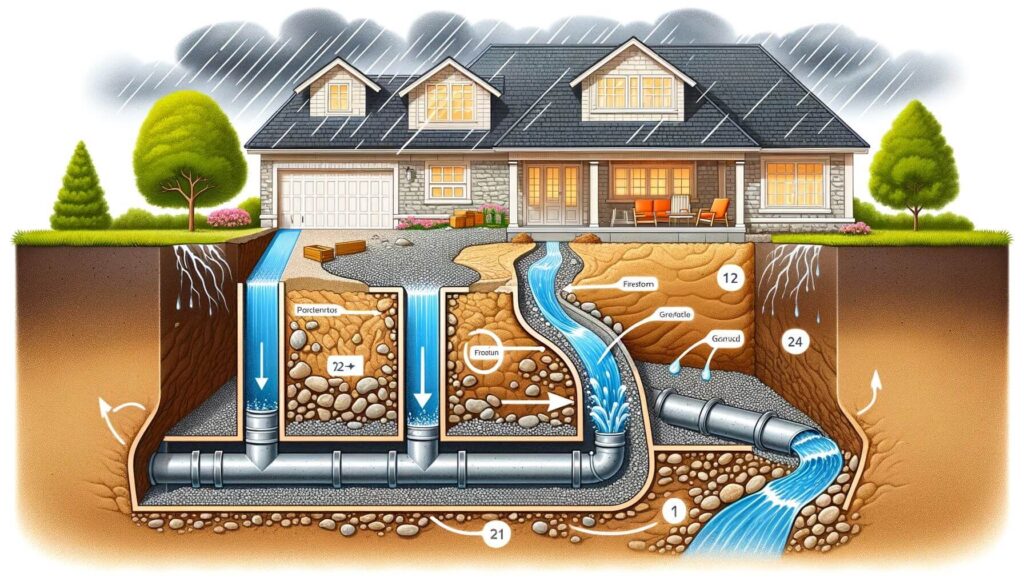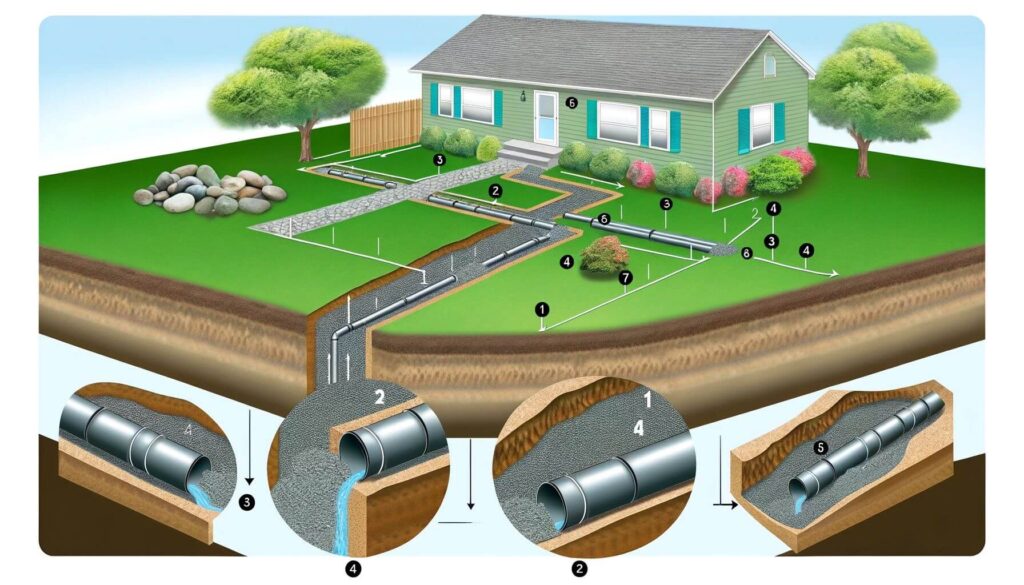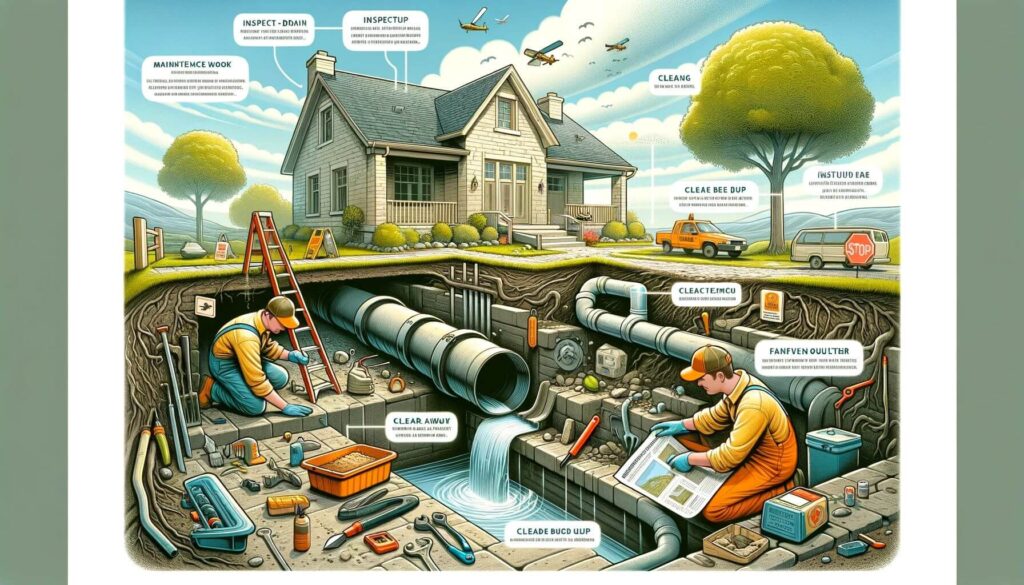
Basement waterproofing stands as a critical measure for homeowners, aimed at safeguarding the lower sections of their residences from unwanted water ingress and the subsequent issues it brings. This process not only ensures the structural integrity of a home but also enhances its living environment, preventing the growth of mold and mildew that thrive in damp conditions.
Among the various waterproofing techniques available, the French drain system emerges as a notably effective and widely adopted solution. Recognized for its ability to efficiently redirect water away from the basement, it plays a pivotal role in maintaining a dry and healthy foundation for homes across diverse regions.
What is a French Drain System For Basement?
A French drain is a waterproofing system designed to intercept and redirect sub-surface water away from the basement, thus preventing water from pooling against the foundation where it can cause damage. The system comprises primarily of a trench filled with gravel or rock containing a perforated pipe. This pipe acts as a conduit for water, channeling it away from the foundation to a safer discharge area, such as a storm drain or a specially designed dry well.
The operation of French drains system rely on gravity to draw water down through the layers of gravel and into the pipe. From there, water flows freely away from the house, guided by the slight incline of the pipe’s installation.
The gravel serves multiple purposes: it filters out debris to prevent clogging of the pipe, facilitates water flow into the pipe, and distributes the water along the entire length of the trench to maximize efficiency.
The combination of these components: gravel, perforated piping, and proper grading, forms a system that effectively mitigates the risk of water damage by keeping basements dry and foundations stable.

The Importance of Basement Waterproofing
The repercussions of moisture accumulation in a basement can be both pervasive and persistent, leading to a range of detrimental outcomes.
Mold and mildew, for instance, find in damp basements a perfect breeding ground. These fungi not only pose health risks, aggravating allergies and respiratory conditions, but also contribute to unpleasant odors that can permeate a home.
Beyond the biological hazards, structural damage is a significant concern. Prolonged exposure to moisture weakens the integrity of foundation walls and flooring, leading to cracks, bowing, and even the potential for catastrophic failure. Furthermore, water infiltration can ruin personal belongings and finished basement spaces, leading to costly repairs and replacements.
Conversely, a dry basement brings manifold benefits. It ensures a healthier living environment by eliminating the conditions that allow mold and mildew to thrive.
Improved air quality benefits not just the basement area but the entire home, as air circulates throughout. From a financial perspective, waterproofing enhances property value.
Homes with effective waterproofing solutions, such as French drains, are more attractive to buyers, who value the assurance against potential water damage and the associated costs. Thus, investing in basement waterproofing is not merely a preventative measure but a strategic enhancement to a home’s livability and marketability.
How French Drains Work to Protect Your Basement

French drains protect basements by intercepting water before it can infiltrate foundation walls. The installation process begins with the excavation of a trench along the perimeter where water accumulation is most likely, either outside the foundation or beneath the basement floor. The trench is then filled with a layer of gravel, and a perforated pipe is laid atop this bed.
The pipe is angled slightly, leveraging gravity to facilitate water flow towards a designated drainage area away from the home. Finally, additional gravel covers the pipe, and the surface is restored, whether with sod on the exterior or concrete for an interior system.
The mechanics of water flow within this system are straightforward yet effective; water drains through the gravel, enters the pipe through the perforations, and is redirected away, thus preventing accumulation around the foundation.
Interior vs. Exterior French Drains
The choice between these two types depends on specific waterproofing needs and the structure of the home.
Exterior French Drain Basement Waterproofing
They are installed around the outside perimeter of the foundation. They are particularly effective at preventing surface water and water from oversaturated soil from reaching the basement walls. This option often involves more extensive excavation and landscaping work.
Interior French Drains or Indoor French Drain
Internal french drains system are suited for situations where water is entering the basement through the floor or the joint where the floor meets the wall. This type involves cutting a channel around the perimeter of the basement floor, installing the drain, and then covering it with concrete.
Interior basement french drain is often used as a solution for homes where external waterproofing is not feasible or as a complement to external systems for comprehensive protection.
Both types of basement french drain waterproofing system serve the essential purpose of mitigating basement water issues, but the choice of system depends on the specific challenges and construction of the home.
Installing a French Drain System

The installation of french drains in basement, whether interior or exterior, involves several critical steps to ensure its effectiveness and longevity. Here’s a generalized step-by-step overview:
Initial Assessment French Drain Inside Basement
Before any work begins, a professional assessment is crucial to determine the most effective location for the French drain, the type (interior vs. exterior), and the specific requirements based on the property’s landscape and water issues.
Excavation
For an exterior drain, this involves digging a trench around the perimeter of the foundation. The depth and width of the trench depend on the extent of water issues and the property’s landscape. For an interior drain, the concrete floor around the perimeter of the basement is cut and removed to create a trench inside.
Laying the Pipe
A perforated pipe is placed at the bottom of the trench. For exterior drains, the pipe is laid on a slight incline to facilitate water flow away from the foundation. For interior drains, the pipe is often surrounded by a fabric filter to prevent clogging.
Filling the Trench
The trench is filled with gravel or a similar aggregate to allow water to flow freely into the drain. The gravel also acts as a filter, preventing soil and debris from entering the pipe.
Finalization
You will cover the trench with soil and the landscape is restored for exterior systems. For interior systems, the trench is covered with new concrete to seamlessly integrate with the existing basement floor.
Importance of Professional Assessment and Installation of French Drain Waterproofing
Professional assessment and installation are paramount for a French drain system. Experts in waterproofing and drainage can identify the precise needs of a property, foresee potential challenges, and devise a tailored solution that ensures long-term effectiveness. Professional installation guarantees that the system is correctly positioned, adequately sloped, and constructed with appropriate materials to maximize its lifespan and functionality.
Maintenance and Care for Your French Drain

To ensure your french drains for basements continues to operate efficiently, regular maintenance and care are essential:
Routine Inspections
Periodically inspect the drain outlets for blockages or buildup. Ensure that the discharge area remains clear and unobstructed to allow water to flow freely away from your property.
Clear Debris
Keep the area around the drain entrance free of leaves, twigs, and other debris that could clog the system. For exterior French drains, this may involve clearing gutters and downspouts that feed into the system.
Check for Sediment
Over time, sediment can accumulate in the pipe, reducing its efficiency. If you notice a decrease in water flow, it may be necessary to flush the system with water to clear out sediment.
How to Identify and Troubleshoot Common Issues with French Drains
Even with diligent maintenance, issues can arise. Here are common signs of trouble and troubleshooting tips:
Reduced Efficiency
If water is not draining as quickly as before, check for clogs or obstructions in the pipe, you may need a professional cleaning.
Water Pooling
If water pools near the drain or foundation, the system may be overwhelmed, incorrectly installed, or damaged. Assessing the gradient of the land and the condition of the drain can identify the problem.
Odor or Mold
Unpleasant odors or visible mold near the drain could indicate a blockage or insufficient drainage. Ensuring proper airflow and inspecting the system for clogs are critical steps.
Maintaining a French drain system is key to its success in keeping your basement dry. Regular checks and cleanings, along with professional guidance when necessary, will extend the life of your French drain and protect your home from water damage.
Cost Considerations
The financial aspect of installing a waterproofing french drain in basement can vary widely depending on several factors. On average, homeowners might expect the cost to range from a few thousand dollars for simple projects to significantly more for complex installations. Key factors influencing the cost include:
Size of the Basement
The larger the area needing protection, the longer the drain system will need to be, increasing both materials and labor costs.
External Landscaping
For exterior French drains, the complexity of the landscape and the necessity to navigate around obstacles such as patios, decks, or mature trees can raise the price. Restoration of landscaping post-installation also contributes to the overall cost.
Depth and Difficulty of Installation
Deeper trenches or installations in areas with difficult terrain or hard soil can increase labor costs.
Additional Basement Waterproofing Measures
Incorporating other waterproofing solutions, like sump pumps or interior sealants, as part of a comprehensive approach to moisture control, can add to the total expense.
It’s important to get multiple quotes from reputable contractors who can assess your specific situation and provide a detailed estimate. This will not only give you a clearer understanding of the costs involved but also the scope of work required for an effective waterproofing solution.
Choosing the Right Solution for Your Home

Determining whether a French drain system is the right solution for your basement waterproofing needs involves understanding the nature of your water problem. French drains are ideal for situations where water accumulates around the foundation or under the basement floor, especially if the issue is related to surface water or a high water table.
Considerations for Choosing a French Drain:
- Water Ingress Location: If water is entering your basement at the floor level or the walls are perpetually damp, a French drain might be the solution.
- Property Slope: Properties that slope towards the foundation, directing water against the basement walls, can benefit significantly from an exterior French drain.
- Existing Water Control Measures: Homes without gutters, downspouts, or properly graded landscapes may find a French drain a necessary addition to other water diversion tactics.
Alternative Waterproofing Methods:
- Interior Sealants and Waterproof Coatings: Best for minor, intermittent leaks, these can be applied directly to the interior basement walls but are not a solution for significant water infiltration.
- Sump Pump Installation: Ideal for basements that experience frequent flooding, a sump pump can remove water that enters the basement, often used in conjunction with a French drain.
- Exterior Waterproofing Membranes: Applied to the outside of foundation walls, these membranes offer a barrier to water entry. They require excavation around the home but provide a strong defense against water intrusion.
When deciding on the best approach, it’s crucial to consult with waterproofing professionals who can evaluate your home’s specific challenges and recommend the most effective, long-term solutions. Each home is unique, and what works for one property may not be the best choice for another.
Professional Assistance vs. DIY
When it comes to installing a French drain system, homeowners may weigh the options between hiring professionals and undertaking the project themselves. Each approach has its pros and cons, and understanding these can help in making an informed decision.
Hiring Professionals:
Pros:
- Expertise and Experience: Professionals bring a wealth of knowledge, ensuring the system is designed and installed correctly.
- Efficiency: With a team of experts, the project can be completed quickly and with minimal disruption.
- Guarantees and Warranties: Many professional installations come with a warranty, providing peace of mind and protection for your investment.
Cons:
- Cost: The primary drawback is the expense, as professional services can be a significant investment.
DIY Installation:
Pros:
- Cost Savings: Handling the installation yourself can save on labor costs.
- Learning Experience: It offers an opportunity to gain new skills and knowledge about home improvement.
Cons:
- Risk of Mistakes: Without the proper experience, there’s a higher risk of errors, which could lead to ineffective waterproofing or even further damage.
- Time and Effort: DIY projects can be time-consuming and physically demanding, especially without a team.
The Importance of Expert Consultation
Regardless of the chosen approach, consulting with a waterproofing expert can provide invaluable insights into the specific needs of your basement. An expert can assess the severity of moisture problems, identify the best waterproofing strategies, and recommend whether a French drain system or another solution is most appropriate for your situation. This consultation can save time, money, and effort in the long run by ensuring that the chosen solution effectively addresses the root causes of water intrusion.
French Drain Basement Conclusion

Throughout this discussion on French drain basement waterproofing, we’ve explored the critical aspects of understanding, installing, and maintaining a French drain system. We’ve highlighted the significance of basement waterproofing for preserving the structural integrity of your home, enhancing indoor air quality, and maintaining property value. The decision between professional installation and DIY, while influenced by cost considerations, ultimately hinges on the need for expertise and the assurance of a correctly implemented solution.
French drains stand out as a robust solution for mitigating basement moisture issues, but they are just one part of a comprehensive approach to waterproofing. Whether you opt for professional installation or decide to take on the project yourself, the key is to act proactively. Addressing water issues early can prevent more severe damage, safeguarding your home’s foundation and ensuring a healthy living environment.
As a homeowners, you are encouraged to assess your basement waterproofing needs carefully. You should seek expert advice when necessary, and take decisive steps toward protecting your basements from water damage. By doing so, you not only protect your investment but also enhance the quality of life within your home.



